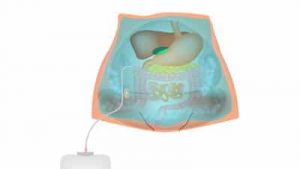This blog summarizes the recent European Association for the Study of the Liver (EASL) guidelines on the management of ascites, spontaneous bacterial peritonitis (SBP) and hepatorenal syndrome (HRS) in patients with cirrhosis.
Cirrhotic ascites occurs as a consequence of portal hypertension and a positive sodium balance. It is estimated that cirrhosis causes 75% of cases of ascites in the U.S. and Western Europe.
The recommendations are as follows:
- A diagnostic paracentesis should be performed in all patients with new-onset moderate- (Grade 2) to large-volume (Grade 3) ascites to determine the etiology of ascites and for all hospitalized patients regardless of the reason for hospitalization
- Ascitic fluid analysis
- Determine the serum-ascites albumin gradient (SAAG)
- A SAAG³1.1 gm/dL indicated portal hypertension with a 97% accuracy
- Cell count with differential to determine whether the patient has SBP
- Culture and gram stain
- Ascitic fluid protein
- Ascitic fluid protein<1.5 gm/dL increases the risk of SBP and warrants SBP prophylaxis
- If the SAAG<1.1, recommend sending ascitic fluid cytology and consider amylase (pancreatic ascites) and AFB RNA by PCR (tuberculous peritonitis) if etiology remains obscure
- Determine the serum-ascites albumin gradient (SAAG)
- Patients with cirrhosis and Grade 2-3 ascites should be referred for orthotopic liver transplantation given two-year mortality rate of 50%
- Sodium restriction to 2 gm daily
- Avoid NSAIDS and non-selective beta-blockers (e.g., propranolol) and recommend against use of ACE inhibitors, angiotensin II receptor blockers, alpha1-receptor blockers and aminoglycosides because of the increased risk of renal impairment
- Patients with Grade 2 ascites
- Add spironolactone 100 mg daily and increase by 100 mg/day every 7 days to a maximum of 400 mg daily
- Aim for no more than 1 pound weight loss daily until patient reaches his/her dry weight
- Add furosemide if patient develops hyperkalemia or does not reach his/her weight loss goal
- Start with furosemide 40 mg PO daily and increase by 40 mg daily every 3-7 days to max 160 mg daily
- Reduce diuretic administration once ascites is controlled to lowest effective dose
- Hold diuretics if patient develops hepatic encephalopathy, acute kidney injury or severe hyponatremia (Na<120) or severe hypokalemia
- Patients with Grade 3 ascites
- Large volume paracentesis
- Start spironolactone 100 mg PO daily AND furosemide 40 mg PO daily and increase spironolactone 100 mg and furosemide 40 mg every 3-7 days to a maximum of 160 mg furosemide and spironolactone 400 mg daily
- Patient with refractory ascites
- Serial large volume paracentesis with albumin
- Increase sodium restriction to 1 gm daily
- Continue diuretics
- Transjugular intrahepatic portosystemic shunt (TIPS) procedure if no contraindications
- Contraindications include: active infection, Tbili>5 mg/dl, INR>2, Childs-Pugh score>11, Grade 2-4 hepatic encephalopathy, moderate-severe pulmonary hypertension, severe TR, CHF, portal vein thrombosis
- Spontaneous Bacterial Peritonitis
- Third-generation cephalosporins
- Albumin 1.5 gm/kg IV on day 1 and 1 gm/kg on day 3, especially for patients with Tbili>4 mg/dl OR serum creatinine>1 mg/dl
- Hyponatremia
- Stop diuretics if Na<120 MEq/L
- Fluid restrict 1 L daily
- Consider tolvaptan for refractory hypervolemic hyponatremia
- Hepatorenal syndrome
- Stop diuretics
- Treat infection if present
- Albumin 1 gm/kg IV on day 1 then 25 gm IV daily thereafter
- Midodrine 7.5-15 mg PO tid
- Octreotide 100-200 mcg SQ tid

Source: Pere Gines et al. EASL clinical practice guidelines on the management of
